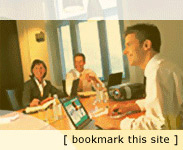
Dierk
Seeburg is Web Content Administrator with
Choice
Hotels International in Phoenix, Arizona. Choice
Hotels is the world's second largest hotel franchiser
with over 5000 hotels in over 40 countries. His responsibilities
at Choice include analysis and scoping of mono- and
multilingual internal and external web content, process
and standards oversight, and translation and quality
assurance of English and German web content. He is
a professional editor, translator, and interpreter
of English and German. Prior to joining Choice he
obtained a Master's degree in biology and served as
adjunct faculty teaching undergraduate students. He
has been a freelance translator and interpreter for
15 years. Open Source Update recently interviewed
Dierk about multilingual web content management and
in particular, Choice's use of the open source CAT
tool
ForeignDesk.
Open Source Update: How did Choice
Hotels International decide to use ForeignDesk?
Did you use another translation tool before this?
Dierk Seeburg: Choice Hotels has
a web content department which includes translation
teams that handle all web-related translation needs
for each of our supported languages for our web
sites. We had completed a major push to move forward
with our effort to internationalize both our intranet
and extranet sites as well as our Internet site.
At the time, we were not using any CAT tool or any
other internationalization or globalization tool.
The volume of incoming translations kept increasing
to the point where we realized that we needed a
tool to aid us in our translation efforts. We researched
the available major commercial tools and the two
major freeware tools using criteria customized to
our file type and workflow requirements. ForeignDesk
is free and open source, does not depend on any
proprietary editor or interface which might lock
us in, has sentence and not paragraph segmentation,
and happens to be very customizable for XML files
through configurable filters. Since our external
websites are XML-based, XML-customizability was
a deciding factor and we decided on ForeignDesk.
OSU: What are some of ForeignDesk's
features as compared with other CAT tools? Are there
features that are unique to ForeignDesk that you
make use of?
DS: Two features that come to mind
right away are the customizability for XML files
as already mentioned above, as well as its instant
and always-on configurable fuzzy matching. Customizability
for XML files allowed us to create custom filters
for our XML-based files for the Choice
Hotels Hot Deals (you can change the language
in the drop down menu) as well as our XML-based
files for Choice
Hotels e-Brochures (you can change the language
by editing the locale in the above URL from en-US
to something like de-DE). The other feature we appreciate
in ForeignDesk is its transparent fuzzy matching
and the ability to instantly see the best fuzzy
match for the given sentence you're working on.
Whenever you work on a particular translation segment
the best fuzzy match is displayed in the fuzzy match
window, and you can browse through the list of fuzzy
matches with lower matching percentages very easily.
OSU: What are your multilingual
content needs? For example, how many languages do
you deal with on your website? How often is the
content updated? Do you have dynamic content in
non-English languages?
DS: We started supporting our fourth
non-English language, Japanese, on choicehotels.com
in October of 2003, and we've been supporting it
in-house since Sept 2004. Four years ago we had
started out with three non-English languages, French,
German, and Spanish. We are always evaluating our
customers' needs, which may lead to adding more
languages over time. We update our content anywhere
from as soon as we get it for customer inquiries
by e-mail to every few months for major website
updates or intranet web application updates. The
majority of our updates, however, is in the range
of one to two weeks for the Choice Hot Deals or
e-Brochures and for medium-size intranet/extranet
and Internet website updates as part of our mini-releases.
Besides static content wrapped into a dynamic XML
wrapper for the Choice Hotels e-Brochures some of
our translated intranet/extranet web applications
are completely dynamic which is one of the leading
edge features for any of the major hotel chains
in the business.
OSU: What members of your IT staff
use ForeignDesk directly?
DS: All members of our translation
teams use ForeignDesk directly, i.e., three members
each per language team. We have four language teams
altogether, five counting the team processing English
web content: English, French, German, Spanish, and
Japanese.
OSU: Are ForeignDesk TMs exchangeable
with TMs from other CAT tools?
DS: We have not had to import TMs
from other CAT tools or export TMs to other CAT
tools, but ForeignDesk is TMX-compliant, so it should
be possible to import and export as long as the
other CAT tool is TMX-compliant, as well. ForeignDesk
also uses an internal TM-format which we have made
use of when merging translation memories from different
translation projects.
OSU: Do you or your developers
contribute to ForeignDesk development, or just use
the releases that come out?
DS: So far, we have not allocated
in-house developer resources to contribute to ForeignDesk
development and just used the releases that came
out. Unfortunately, external development seems to
have ground to a halt - I have not seen any new
files announced in quite a while. This has prompted
us to start looking for options and other tools
which include technical support. We may change our
strategy in the future, if we see that ForeignDesk
could remain our CAT tool platform in the medium-
to long-term future.
OSU: Can you describe a typical
translation/localization project workflow using
ForeignDesk?
DS: A lot of our work revolves
around translating and updating the Choice Hotels
e-brochures. We receive notification of updates
made by the Choice Hotels Destination Content team
from the prior business day through an automated
process. After individual translators synchronize
their local file repository they add the updated
files to the ForeignDesk project containing the
previous e-brochure files of the region in question.
Upon opening the project in ForeignDesk and opening
the files requiring updates ForeignDesk fills in
all sentences previously translated, i.e., those
with a 100% match, automatically and suggests fuzzy
matches for the sentences where no 100% match was
found. Translators complete the remaining translations
and 'build' the updated ForeignDesk project. Lastly,
translators check the updated files back into the
repository from where they are uploaded into production
through an automated process every night.
OSU: What do you see as the advantages
of an open source CAT tool?
DS: Well, let's start with the
definition of it: open source means that the source
code is both freely available for anyone to study
and open to be modified. The upshot of that is its
usually superior reliability as a result of being
a community project of some sort with lots of community
members contributing a little bit of their time
to help in bug hunting or troubleshooting. Due to
its transparency, it's also less vulnerable to viruses
since possible points of attack have been eliminated
at some point during the community quality assurance
process.
A convenient side effect of freely available source
code is that there are no license costs associated
with the software. Costs are, of course, a big factor
when it comes to commercially available CAT tools
which can run into the thousands of dollars for
some of the networkable editions sporting database
backends which are often part of the tool suite
of the major CAT tool competitors. Taking into account
upgrade costs that become necessary due to lock-in,
in the case of a commercial tool, the total cost
of ownership is often cited as significantly lower
than for commercial tools even taking into account
time spent on user forums to solve technical problems
with an open source tool.
OSU: Do you see yourselves continuing
to use ForeignDesk in the future?
DS: Although ForeignDesk has been
a very useful tool to date, we are always evaluating
other tools which may improve our efficiencies including
better handling of the networking aspect of our
project management, supporting other file types
like Java properties files natively, and providing
a web application interface for translations.
OSU: What resources does a for-profit
business need in order to make the best use of an
open source CAT tool?
DS: In the case of ForeignDesk,
we felt very fortunate that we did not require any
developer resources to customize our installation
of ForeignDesk - it just worked right out of the
box. Thanks to the ample documentation stemming
from the days before ForeignDesk was open sourced
by Lionbridge, our team has been able to train new
employees rather quickly, with training coming from
the two-person team originally tasked with researching
free CAT tool solutions and therefore most familiar
with ForeignDesk.
OSU: Dierk, thanks a lot for your
time.
DS: My pleasure, thanks for your
work on Open Source Update.



 Dierk
Seeburg is Web Content Administrator with Choice
Hotels International in Phoenix, Arizona. Choice
Hotels is the world's second largest hotel franchiser
with over 5000 hotels in over 40 countries. His responsibilities
at Choice include analysis and scoping of mono- and
multilingual internal and external web content, process
and standards oversight, and translation and quality
assurance of English and German web content. He is
a professional editor, translator, and interpreter
of English and German. Prior to joining Choice he
obtained a Master's degree in biology and served as
adjunct faculty teaching undergraduate students. He
has been a freelance translator and interpreter for
15 years. Open Source Update recently interviewed
Dierk about multilingual web content management and
in particular, Choice's use of the open source CAT
tool ForeignDesk.
Dierk
Seeburg is Web Content Administrator with Choice
Hotels International in Phoenix, Arizona. Choice
Hotels is the world's second largest hotel franchiser
with over 5000 hotels in over 40 countries. His responsibilities
at Choice include analysis and scoping of mono- and
multilingual internal and external web content, process
and standards oversight, and translation and quality
assurance of English and German web content. He is
a professional editor, translator, and interpreter
of English and German. Prior to joining Choice he
obtained a Master's degree in biology and served as
adjunct faculty teaching undergraduate students. He
has been a freelance translator and interpreter for
15 years. Open Source Update recently interviewed
Dierk about multilingual web content management and
in particular, Choice's use of the open source CAT
tool ForeignDesk.